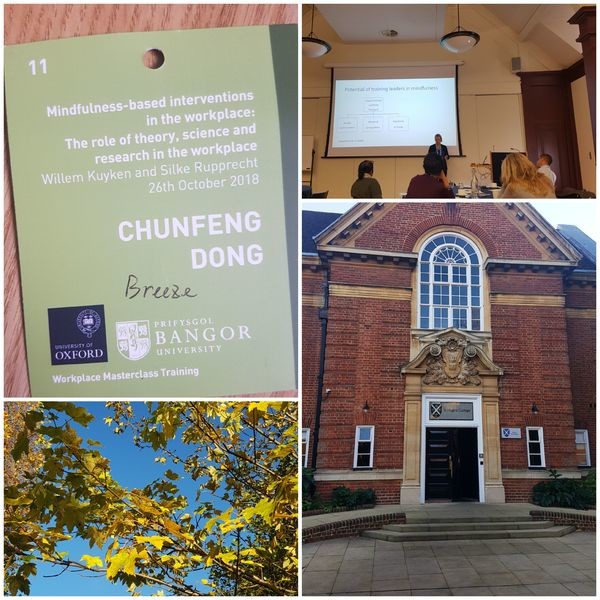Mindfulness in the work place
Last week I had the pleasure to attend the Mindfulness master class in Oxford. This is a milestone for me completing the pathway of the Mindfulness in the work place Certificate. I feel really honored to connect to some of the founding fathers to bring mindfulness to the workplace.
My commitment of mindfulness originated from Buddhism meditation. I can honestly say that mindfulness practice along with the wisdom of non-duality transformed my life. While keeping my personal practice, I wondered how can I be a vessel to spread the word of these amazing techniques?
Back in 2014 I attended the 2nd Mindfulness@Work conference in Cranfield University, where the sincere intentions of participants deeply struck me. I started to search for secular ways to bring this awareness to more interested people. Much encouragingly, some years later in 2018 I read the book 《Altered Traits》by scientists Daniel Goleman and Richard Davidson. In this book Dan and Richard told their story when they were directly asked by the Dalai Lama to investigate the applications of meditation and extract useful bits for wider audience. They were also the first western scientists to conduct a systematic brain research showing the long-term effect mindfulness meditation has on one’s brain. In other words, traits that are developed through Neuroplasticity and epigenetics based on long-term mindfulness practice. These are transformational of our lives. I resonate a lot with their research as I attended Vipassana silent retreats which lightened my way.
Dan and Richard described 2 approaches of mindfulness: the deep path and the wide path. The deep path is largely pursued by Buddhist meditators, yogies etc, whom I admire and I could only aspire for my personal practice. The wide path is made available firstly by Prof. Jon Kabat Zinn bringing mindfulness based approaches in clinical settings. And more recently by Mark Williams in Oxford Mindfulness Center and colleagues in Bangor University in a wide variety of MBSR MBCT approaches. The Certificate of Teaching Mindfulness in the workplace is the workplace focused program by OMC and Bangor. Learning with them is a wonderful experience. I learnt not only about positioning Mindfulness in the workplace, teaching methodologies, but also many practical examples showing the community what are moving in this space.
Then, the session with OMC Prof. Willem Kuyken and Dr. Silke Rupprecht really touched me. Willem’s facilitation was authentic and insightful. He reminded us to bring ourselves back to the core intention of this work. This was so helpful for me at this stage. It brought me back to the first three hand half days of the Vipassana retreat, when my mind kept wondering off like a crazy monkey. Last month I started the adventure of my coaching and consulting practice, while keeping the connection in the corporate world. In bringing the creative consciousness and fostering mindfulness in the corporate environment, I observed a certain desire for target achievements in me. A desire to help and desire to push. However, this can be a trap that I set for myself as this again is tayloristic thinking. It’s such a delicate dance for self-work as well as external work. The masterclass was filled with moments of silence. I noticed in those moments, we didn’t have to strive for tangible achievements on the surface, but the connection we built with our intention really prevailed.
Therefore my “aha” moment is: always touch base with the core intention, this is the only way we could keep ourselves checked and balanced. Not to fall into any ego-centric trap, and at the same time, make quality progress. Only when we live the life we preach, could we reach others. The key word for me today is embodiment.
p.s. today I read a comment from one of my teachers, which resonate with me a lot in this space. He said: “智慧”是指意识层面的智慧。先让自己的心静下来,让心有足够的空间开发智慧,再用智慧把善与恶的动机分辨清楚。这点非常重要。 “Wisdom is at the deep consciousness level. When we quiet down our mind, our mind will have sufficient space to develop wisdom. Then we can use this wisdom to distinguish the positive and negative intentions, this is very important. ”
From the nerdy part of me, I’d like to link that with my conversation with a neuroscientist. The silence provides a space for our brain to make neuron connections in different parts. In other words, to face the future paradigm shifts, we need to tap into our unique human capacities. To tap into our deeper wisdom and creativity, that requires us to activate different parts of our brain. And so far as I’ve experienced, such mindful moments will create that space.


